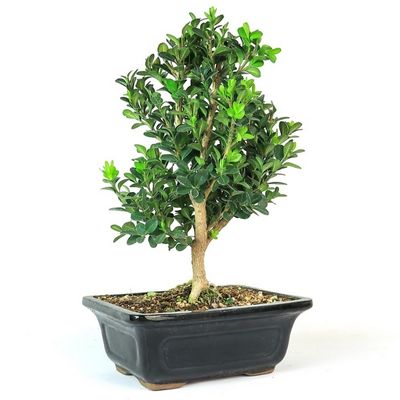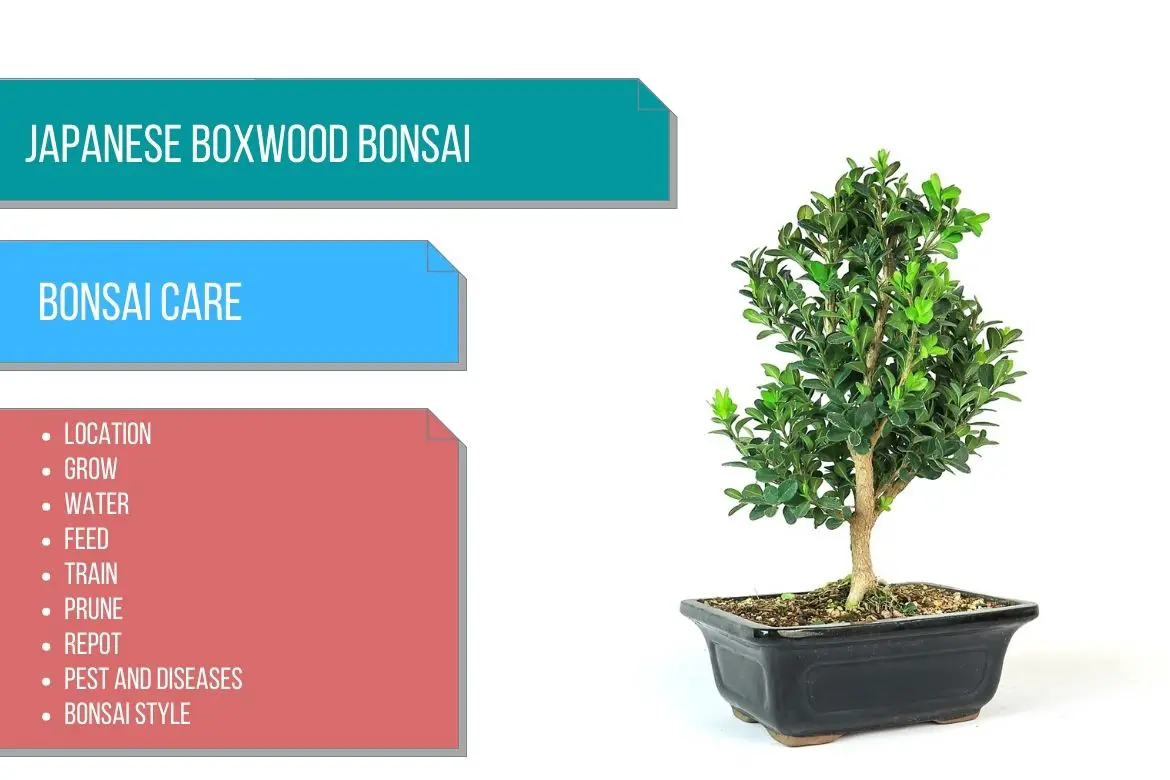
Japanese Boxwood
(Buxus microphylla var. japonica)
Country of Origin : Japan
Bonsai Styles : Informal upright, clump style
Zone : 6 – 9
Japanese boxwood is an evergreen shrub. It is an excellent candidate for both large and small bonsai specimens.
This tree should not be confused with Buxus harlandii (Harland boxwood – Also called as Chinese boxwood). Please click here to know more about Chinese boxwood bonsai tree.
These trees are extremely slow growing. It tends to be small and has a tight growth habit. These qualities make Japanese boxwood one of the ideal candidates for growing in a container.
It has tiny rounded leaves which are light green in color. These tiny leaves are borne close together to form a dense foliage structure.
Japanese boxwood bonsai can also flower occasionally. However, it is very rare. In case it does flower, the flowers are inconspicuously small and yellow in color.
The tiny structure of its leaves and branches gives the Japanese boxwood bonsai tree a perfectly miniaturized tree look.
Due to its adaptability to a wide range of outdoor growing conditions, it is one of the few temperate cold-hardy plants that grow well as indoor bonsai.
In fact, most of the bonsai enthusiasts prefer this tree as an indoor bonsai only.
Read more about other bonsai trees species in : Types of bonsai tree

Poisonous for pets; Japanese boxwood bonsai is mostly grown as indoor bonsai. Prevent your pets from consuming the leaves of the tree. Pets may suffer heavy sickness or even cause death.
Japanese boxwood (Buxus microphylla) should not be confused with American boxwood / Common boxwood (Buxus sempervirens). One of the ways you can differentiate the two varieties is : Buxus microphylla has rounded leaves and Buxus sempervirens has pointy leaves.
Best location to keep Japanese Boxwood Bonsai
Despite being a temperate shrub, Japanese boxwood bonsai tolerates cool indoor temperatures quite well.
Cold temperatures (indoors) are preferred by Japanese boxwood bonsai, approximately 55°F to 65°F (12°C to 18°C) during the winter.
A suitable average temperature for the rest of the year can be between 65°F to 75°F (18°C to 23°C).
In summer, it can be kept outdoors. However, move the bonsai container indoors in case the temperature drops below 50°F (10°C).
When placing indoors, a west or south facing window or windowsill is a good option.
Also read, how to choose a bonsai pot for your bonsai.
Click here to read our detailed guide to indoor bonsai tree care.
Refer sunlight requirements for indoor plants for more indoor gardening ideas. Also, refer to do bonsai trees need sunlight for more indoor and outdoor bonsai location ideas.
Propagation of Japanese Boxwood tree
Japanese boxwood can be propagated by using stem cuttings. make sure to use a bunch of stems as not all the stems will root. Also, use rooting hormone.
Almost any time of year is suitable for cuttings, but they are best taken when the stems are flexible and snap when pushed a little too far.
I would recommend getting the tree from nursery stock.
You can also perform air layering.
Watering Japanese Boxwood Bonsai
Watering the bonsai tree depends on the type of atmosphere it is subjected to. In summers, the watering frequency will be high and and winters, water the bonsai less frequently.
Even though Japanese boxwood can tolerate brief periods of dry spells, it is always a good idea to keep the bonsai soil moist. Don’t let it dry out completely.
Avoid watering the Japanese boxwood from above, as wet foliage may cause leaf diseases. Hence, avoid spraying mist on the bonsai tree also.
Japanese boxwood bonsai needs a good amount of water. However, make sure that the soil is not waterlogged. Or else the roots will rot.
Immersion technique is the best watering method to water these bonsai trees.
Read watering bonsai tree for more details about immersion technique.
Wiring Japanese Boxwood Bonsai
Take great care when wiring Japanese boxwood branches, as they are extremely brittle.
In case you decide to wire, make sure that you do not damage the bark. The scar marks on the bark are unsightly and remain on the trunk for a long time.
You can use guy wire for older branches.
Read : Detailed guide on How to wire a bonsai. This extensive guide includes all the wiring techniques and Do’s and Dont’s. It will also show you other bonsai training techniques which can be achieved without using wires.
Pruning Japanese Boxwood Bonsai
When to prune Japanese Boxwood bonsai?
How to prune Japanese Boxwood bonsai?
The Japanese boxwood bonsai tree has a lot of budding, and it has many branches that can be styled. Hence, at the time of pruning, you will end up thinking a lot about which shape will look best on your bonsai tree.
Early spring is the ideal time to cut back Japanese boxwood hard and then use the “clip-and-grow method” to develop your desired shape and bonsai style. Deadwood can also be sculpted to great extent on this tree.
If the tree’s shape is set, let its branchlets grow four to five sets of leaves, then prune them back to two sets to create a well-defined, sculpted silhouette.
As the tree has a tendency of becoming dense, thin out the dense canopy to let air and light enter the inner sections of the bonsai tree.
Read how to prune a bonsai to know about the right technique of pruning and more about defoliating a bonsai tree.
Repotting Japanese Boxwood Bonsai
When to repot Japanese Boxwood bonsai?
Japanese boxwood bonsai can be repotted every second years. It depends on the maturity of the bonsai tree. Older bonsai trees can be repotted in every 4-5 years.
The bonsai tree’s root development determines how often it needs to be repotted. Keep an eye on whether the roots are pot bound.
Japanese boxwood bonsai can tolerate root pruning pretty well. Hence prune some roots when repotting. Do not remove more than 1/3 of the root system though.
You can use a free-draining, bonsai soil mix.
Please check out how to repot a bonsai to know everything about repotting and root pruning a bonsai.
Must Read: Bonsai Soil Recipes
Must read : Choosing the right bonsai container
Feeding Japanese Boxwood Bonsai
Weekly fertilize your boxwood with a half strength fertilizer that is well-balanced.
In winter, reduce the frequency to once every two to three weeks.
Once a month, supplement with an acidic fertilizer for azaleas or camellias at half strength.
Read more about bonsai fertilizer and its application.
Diseases and pest of Japanese Boxwood Bonsai
Boxwood blight can cause some issues to the bonsai. The bonsai might start loosing its leaves. This fungal disease can be identified by black spots on the leaves. Remove the effected leaves.
Root rot can occur in case the bonsai soil mix is not well drained.
Japanese boxwood Bonsai plants can also be defoliated by boxwood moths and caterpillars. Remove them by hand or use a systemic insecticide in case the issue persists.
Blistering of leaves, brown splotches and raised areas are a sign of boxwood mites. These pests are somewhat hard to see with naked eyes. Use a suitable insecticidal soap or a ‘miticide‘.
Please make sure you read our comprehensive guide: How to identify and treat bonsai pests and diseases is a great resource for you to see all the organic and inorganic remedies you can use.
Japanese Boxwood bonsai care
Your Japanese boxwood bonsai tree can experience stunted growth in 2 conditions: if the roots are pot bound or if it is not receiving enough water.
You can also opt for complete defoliation of the leaves in case you desire to have even smaller leaves on your bonsai. However be careful as this is very stressful for the tree. Do the complete defoliation in early summer so that the bonsai tree has time to recover before the start of the winter.
What to look for when buying Japanese Boxwood Bonsai
As stated earlier, boxwood branches are stiff and brittle. One has to wire them very carefully. However, most of the people skip the wiring and prefer shaping the bonsai tree by just pruning.
When out in the market looking for a Japanese boxwood bonsai tree, look for a bonsai specimen which already has a branch structure which suits your style. This will help you in avoiding all the wire training hassles.
Find a plant with good trunk curvature and branches that emerge where you want them to.
Japanese boxwood tree forms its root system pretty deep in the soil. Look for a specimen which is holding tightly to the pot.

